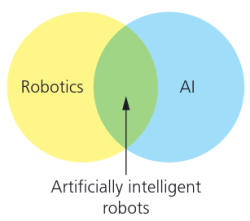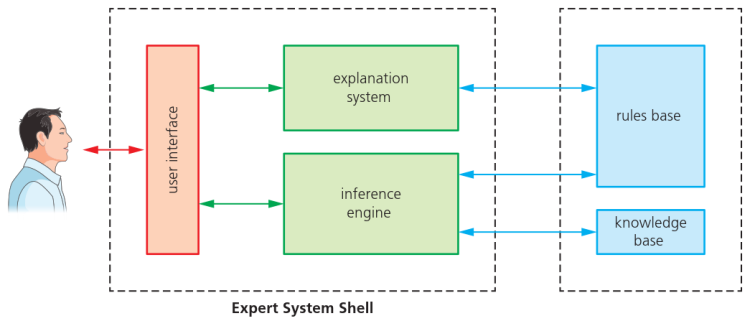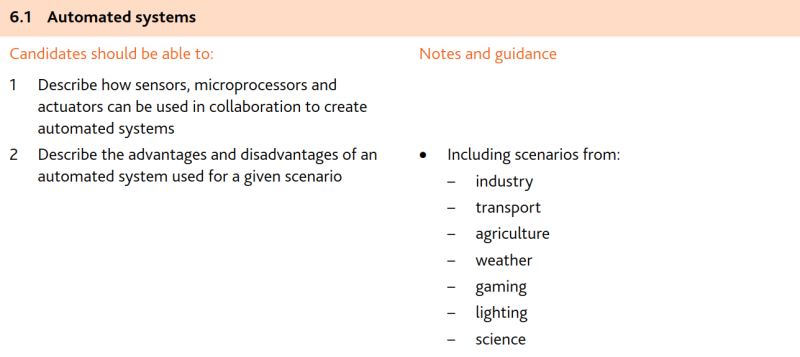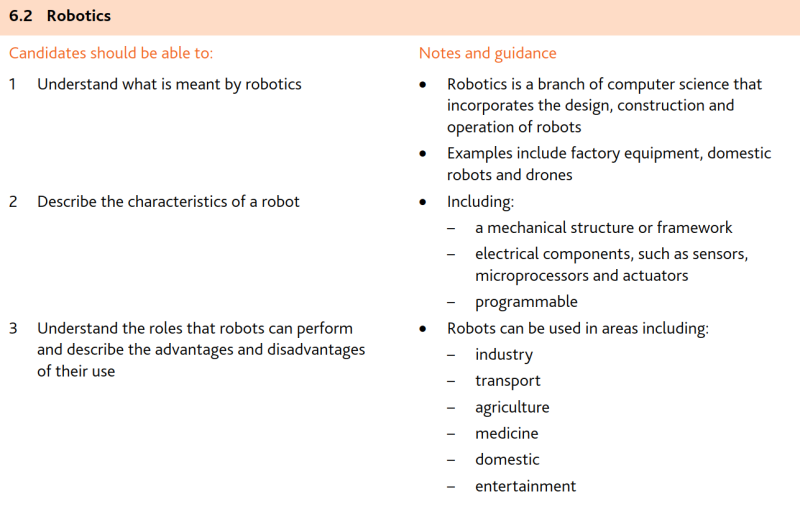CAIE IGCSE CS revision - Unit 6 (2023)
如遇到公式加载异常,请刷新页面!
Unit 6 Automated and emerging technologies 自动化和新兴技术
6.1 Automated systems 自动化系统
- 大纲要求
6.1.1 Describe how sensors, microprocessors and actuators can be used in collaboration to create automated systems 描述如何协同使用传感器、微处理器和执行器来创建自动化系统
- Automated system:自动化系统,指软件和硬件组合后经过设计和编程,能够无需任何human intervention人工干预即可自动工作。
- 注意:尽管自动化系统无需人工干预即可工作,但目前仍需要human monitoring人工监督。
- Sensors传感器、microprocessors微处理器和actuators执行器的协作:
- Sensors传感器用于检测和输入相关数值。这些数值会传送给微处理器。
- microprocessors微处理器接收到相关数值,会根据设定好的程序进行计算,并向执行器下达相关指令信号。
- actuators执行器获得信号后,根据指令进行相关操作(如开关、洒水等)。
6.1.2 Describe the advantages and disadvantages of an automated system used for a given scenario 描述用于给定场景的自动化系统的优点和缺点
• Including scenarios from: 包括以下场景:
- industry工业
- transport交通
- agriculture农业
- weather天气
- gaming游戏
- lighting照明
- science科学
- Industry工业中自动化系统的优点:
- Much faster than a human operator. 比人类操作员快得多。
- Much safer (keep humans away from a dangerous environment). 更安全(让人类远离危险环境)。
- More likely run under optimum conditions. 更有可能在最佳条件下运行。
- Less expensive in the long run. 从长远来看更便宜。
- More efficient use of materials. 更有效地利用材料。
- Higher productivity. 更高的生产力。
- More consistent results. 更一致的结果。
- Industry工业中自动化系统的缺点:
- Expensive to set up in the first place and needs considerable testing. 初次设置费用昂贵,并且需要进行大量测试。
- Always possible for a set of conditions to occur that were never considered during testing (need for a supervisor). 总是可能发生在测试期间从未考虑过的问题(需要监督)。
- Any computerised system is subject to cyberattacks. 任何计算机化系统都容易受到网络攻击。
- Automated systems always need enhanced maintenance which can be expensive. 自动化系统总是需要加强维护,费用可能很昂贵。
- transport交通中自动化系统的优点:
- Allow the same number of cars to use fewer parking spaces. 让同样数量的汽车使用更少的停车位。
- Avoid traffic disruption in cities. 避免城市交通中断。
- Cars can fit into smaller spaces. 汽车可以适应更小的空间。
- Fewer dents and scratches to cars (reduced insurance claims). 减少汽车的凹痕和划痕(减少保险索赔)。
- Safer (for cars and other people). 更安全(对于汽车和其他人)。
- Very consistent results. 非常一致的结果。
- transport交通中自动化系统的缺点:
- Over-reliance on automated systems (loss of skills). 过度依赖自动化系统(技能丧失)。
- Faulty/dirty sensors or cameras can send false data/images to the on-board. 有故障/脏的传感器或摄像头可能会向车载设备发送错误的数据/图像。
- Computer which could lead to a malfunction. 计算机可能导致故障发生。
- The sensors may not pick-up low kerbs. 传感器可能无法拾取低路沿。
- Expensive option. 昂贵的选择。
- Additional maintenance. 额外维护。
- agriculture农业中自动化系统的优点:
- Reduced labour costs. 降低劳动力成本。
- Better and more efficient control of the irrigation process. 更好、更有效地控制灌溉过程。
- Better control of precious resources. 更好地调控宝贵的资源。
- Faster response than a human. 比人类更快的反应。
- Safer for people. 对人更安全。
- Different growing conditions can be maintained simultaneously. 可以同时保持不同的生长条件。
- agriculture农业中自动化系统的缺点:
- Expensive to set up initially. 初始建造成本高昂。
- Very high maintenance costs. 维护成本非常高。
- Increased need to maintain the water channels. 维护水道的需求增加。
- weather天气中自动化系统的优点:
- save labour. 节省劳动力。
- gather information from remote regions or where constant weather data is a requirement. 从偏远地区或需要恒定天气数据的地方收集信息。
- gaming游戏中自动化系统的优点:
- Embedded accelerometers and proximity sensors (together with a microcontroller) in games consoles allow increased human interaction with the game. 游戏机中的嵌入式加速度计和接近传感器(连同微控制器)可以增加人与游戏的互动。
- lighting照明中自动化系统的优点:
- Control light sources automatically. 自动控制光源。
- A reduced energy consumption. 减少能源消耗。
- Wireless connections can be chosen which are much safer (no trailing wires). 可以选择更安全的无线连接(无尾线)。
- Longer bulb life. 灯泡寿命更长。
- Possible to program new light displays for various occasions. 可以为各种场合编程新的灯光显示。
- lighting照明中自动化系统的缺点:
- Expensive to set up. 设备安装费昂贵。
- Wireless connections are less reliable than wired systems. 无线连接不如有线系统可靠。
- More maintenance (expensive). 更多维护费。
- science科学中自动化系统的优点:
- More consistent (repeatable) results. 更一致(可重复)的结果。
- Less dangerous. 不那么危险。
- Faster results (several different experiments can be done simultaneously). 更快的结果(可以同时进行几个不同的实验)。
- Automatic analysis of the results is possible. 可以自动分析结果。
- Fewer highly trained staff needed. 需要更少的训练有素的员工。
- Results/experiments can be monitored anywhere in the world in real time. 可以在世界任何地方实时监控结果/实验。
- science科学中自动化系统的缺点:
- Less flexible than when using human technicians. 不如使用人工技术人员灵活。
- Security risks are always present. 安全风险始终存在。
- Equipment can be expensive to buy and set up. 设备的购买和安装可能很昂贵。
6.2 Robotics 机器人
- 大纲要求
6.2.1 Understand what is meant by robotics 理解机器人的含义
• Robotics is a branch of computer science that incorporates the design, construction and operation of robots 机器人学是计算机科学的一个分支,结合了机器人的设计、构造和操作
• Examples include factory equipment, domestic robots and drones 示例包括工厂设备、家用机器人和无人机
- Robotics:机器人学,属于计算机科学的分支,主要研究机器人的design设计、construction构造和operation操作。
- Three laws of robotics:机器人学的三原则
- 原则1:A robot may not injure a human through action or inaction. 机器人不得通过行动或不行动来伤害人类。
- 原则2:A robot must obey orders given by humans, unless it comes into conflict with law 1. 机器人必须服从人类的命令,除非它与原则1相冲突。
- 原则3:A robot must protect itself, unless this conflicts with law 1. 机器人必须保护自己,除非这与原则1相冲突。
6.2.2 Describe the characteristics of a robot 描述机器人的特征
• Including: 包括:
- a mechanical structure or framework 机械结构或框架
- electrical components, such as sensors, microprocessors and actuators 电气元件,例如传感器、微处理器和执行器
- programmable 可编程
- robot机器人的特征:
- Ability to sense their surroundings (Done via sensors):感知周围环境的能力(通过传感器完成)
- Have a degree of movement:有一定程度的移动能力
- Make use of wheels, gears (etc.) to carry out functions利用轮子、齿轮等来执行功能
- Mechanical structures made up of many parts. 由许多零件组成的机械结构
- Contain many electrical components. 包含许多电气元件
- Make use of end effectors. 使用末端执行器
- Programmable (Done via controller):可编程(通过控制器完成)
- 注意:机器人不一定长得像人类,只要满足上述特征,均可认为是机器人(包括机械臂、大型设备等)。
- 机器人的分类:
- 按照物理形态划分:
- Physical robots:物理机器人,即日常生活中最常见的机械性机器人。
- Software robots:软件机器人,即search engine bot搜索引擎、chat bot聊天机器人等。
- 注意:软件机器人目前不算是真正意义上的机器人(因为不满足机器人的特征)
- 按照是否依赖人划分:
- Independent robots:独立型机器人,指无需人类直接控制,可以完全取代人类完成任务的机器人。
- Dependent robots:依赖型机器人,指运行时需要人类从旁干预的机器人,干预行为包括操作计算机或者使用control panel控制台等。该类型机器人可以部分取代人类完成任务。
- 按照物理形态划分:
6.2.3 Understand the roles that robots can perform and describe the advantages and disadvantages of their use 了解机器人可以扮演的角色并描述其使用的优缺点
• Robots can be used in areas including: 机器人可用于以下领域:
- industry工业
- transport运输
- agriculture农业
- medicine医药
- domestic家庭
- entertainment娱乐
- Robots in the industry:工业用机器人,通过embedded microprocessors嵌入式微处理器或由计算机系统控制,完成一系列生产任务。部分机器人还配有sensors传感器,可根据周围环境做出相应处理。
- 机器人在industry工业中使用的好处:
- robots are capable of working in conditions that may be hazardous to humans. 机器人能够在可能对人类有害的条件下工作
- robots work 24/7 without the need to stop. 机器人全天候工作,无需停下来
- robots are less expensive in the long run (since there will be fewer salaries to pay). 从长远来看,机器人更便宜(因为几乎无需支付工资)
- robots are more productive than humans (higher productivity). 机器人比人类更有生产力(生产效率高)
- although not necessarily more accurate, robots are more consistent. 虽然不一定更准确,但机器人更一致(听话)
- robots are better suited to boring, repetitive tasks than humans (therefore less likely to make mistakes). 机器人比人类更适合枯燥、重复的任务(因此不太可能犯错误)
- there will be less cost in heating and lighting (robots don't need good light or warmth). 加热和照明的成本会更低(机器人不需要良好的光线或温暖)
- 机器人在industry工业中使用的问题:
- robots can find it difficult to do 'non-standard' tasks (for example, windscreen being fitted to a car is cracked). 机器人会发现很难完成“非标准”任务(难以随机应变)
- robots can lead to higher unemployment amongst manual labour tasks. 机器人的使用可能导致更高的失业率(技术型失业)
- there is a risk of deskilling when robots take over certain tasks (for example, welding and paint spraying). 当机器人长期从事某些任务(如焊接和喷漆)时,人类的技能可能会失传或退化
- factories can now be moved to anywhere in the world where operation costs are lower (leading again to unemployment in some countries). 工厂现在可以转移到世界上运营成本较低的任何地方(导致一些国家失业问题突出)
- robots are expensive to buy and set up in the first place. 机器人的购买和安装成本很高
- 机器人在industry工业中使用的好处:
- autonomous vehicles:自动驾驶汽车,通过camera摄像头从周围环境中捕捉视觉数据,而radar雷达和ultrasonics超声波则允许车辆建立周围环境的3D图像。
- 机器人在transport运输中用于autonomous vehicles自动驾驶汽车的好处:
- safer since human error is removed leading to fewer accidents. 更安全,因为消除了人为错误,从而减少了事故
- better for the environment since vehicles will operate more efficiently. 对环境更好,因为车辆将更有效地运行
- reduced traffic congestion (humans cause 'stop-and-go' traffic known as 'the phantom traffic jam', autonomous vehicles will be better at smoothing out traffic flow reducing congestion in cities). 减少交通拥堵(人类造成的“走走停停”交通被称为“幻影交通拥堵”,自动驾驶汽车将更好地疏通交通流量,减少城市拥堵)
- increased lane capacity (research shows autonomous vehicles will increase lane capacity by 100% and increase average speeds by 20%, due to better braking and acceleration responses together with optimized distance between vehicles). 增加车道通行能力(研究表明,由于更好的制动和加速响应以及优化的车辆间距,自动驾驶汽车将使车道通行能力增加 100%,平均速度提高 20%)
- reduced travel times (for the reasons above) therefore less commuting time. 减少旅行时间(由于上述原因)因此减少通勤时间
- stress-free parking for motorists (the car will find carparking on its own and then self-park). 为驾驶者提供无压力停车(汽车会自行找到停车位,然后自行停车)
- 机器人在transport运输中用于autonomous vehicles自动驾驶汽车的问题:
- very expensive system to set up in the first place (high technology requirements). 首先要建立非常昂贵的系统(高技术要求)。
- the ever-present fear of hacking into the vehicle's control system. 车辆控制系统可能被黑客入侵。
- security and safety issues (software glitches could be catastrophic; software updates would need to be carefully controlled to avoid potential disasters). 安全和安全问题(软件故障可能是灾难性的;需要仔细控制软件更新以避免潜在的灾难)。
- the need to make sure the system is well-maintained at all times; cameras need to be kept clean so that they don't give false results; sensors could fail to function in heavy snowfall or blizzard conditions (radar or ultrasonic signals could be deflected by heavy snow particles). 确保系统始终得到良好维护的需要;相机需要保持清洁,以免给出错误的结果;传感器可能无法在大雪或暴风雪条件下工作(雷达或超声波信号可能会被大雪颗粒偏转)。
- driver and passenger reluctance to use the new technology. 司机和乘客不愿意使用新技术。
- reduction in the need for taxis could lead to unemployment (imagine New York without its famous yellow cabs!). 出租车需求的减少可能会导致失业。
- 机器人在transport运输中用于autonomous vehicles自动驾驶汽车的好处:
- Autonomous trains:自动驾驶火车,LiDaR(Light Detection and Ranging光探测和测距)使用laser激光建立周围环境的3D图像。
- 机器人在transport运输中用于autonomous trains自动驾驶火车的好处:
- this improves the punctuality of the trains. 提高了火车的准时性
- reduced running costs (fewer staff are required). 降低运行成本(需要更少的员工)
- improves safety since human error is removed. 由于消除了人为错误,提高了安全性
- minimises energy consumption since there is better control of speed and an optimum service requires less energy (trains stuck in stations still use energy). 最大限度地减少能源消耗,因为可以更好地控制速度,达到最佳服务需要更少的能源(停在车站的火车仍然需要能源)
- it is possible to increase the frequency of trains (automated systems allow for shorter times between trains]it is easier to change train scheduling (for example, more trains during busier times). 可以增加火车的频率(自动化系统允许更短的火车之间的时间)更改火车调度更容易(例如,在繁忙时间增加火车)
- 机器人在transport运输中用于autonomous trains自动驾驶火车的问题:
- the ever-present fear of hacking into the vehicle's control system. 火车控制系统可能被黑客入侵。
- system doesn't work well with very busy services (at the moment). 系统不适用于非常繁忙的服务,容易崩溃(至少目前如此)。
- high capital costs and operational costs initially (that is, buying the trains, expensive signalling and control equipment and the need to train staff). 最初的高资本成本和运营成本(购买火车、昂贵的信号和控制设备以及培训员工等)。
- ensuring passenger behaviour is acceptable particularly during busy times (for example, jamming doors open on trains, standing too near the edge of platforms and so on). 需要确保乘客的行为合乎自动化系统的要求,尤其是在繁忙时段(如火车上的门卡住,站得太靠近站台边缘等)。
- passenger reluctance to use the new technology. 乘客不愿使用新技术。
- no drivers mean there will be a need for CCTV to monitor railway stations. 需要闭路电视监控火车站。
- 机器人在transport运输中用于autonomous trains自动驾驶火车的好处:
- Autonomous airplane:自动驾驶飞机,使用auto-pilot自动驾驶仪来控制飞行,人类飞行员仅在起飞和降落期间接管。
- 机器人在transport运输中用于autonomous airplane自动驾驶飞机的好处:
- Improvement in passenger comfort (reasons given earlier). 提高乘客的舒适度。
- reduced running costs (fewer staff are required). 降低运行成本(需要更少的员工)。
- improved safety (most crashes of airplanes have been attributed to pilot-induced errors). 提高安全性(大多数飞机坠毁都归因于飞行员引起的错误)。
- improved aerodynamics at the front of the airplane since there would no longer be the need to include a cockpit for the pilots. 改进了飞机前部的空气动力学,因为不再需要为飞行员提供驾驶舱。
- 机器人在transport运输中用于autonomous airplane自动驾驶飞机的问题:
- security aspects if no pilots on-board (for example, handling terrorist attacks). 安全方面可能需要加强(如处理恐怖袭击)。
- emergency situations during the flight maybe difficult to deal with. 飞行中的紧急情况可能难以处理。
- hacking into the system (it might be possible to access flight controls). 飞行控制系统可能被黑客入侵。
- passenger reluctance to use the new technology. 乘客不愿使用新技术。
- software glitches (recent software issues with modern airplanes have highlighted that software glitches can have devastating results). 软件故障(现代飞机最近的软件问题突出表明,软件故障可能会造成毁灭性的后果)。
- 机器人在transport运输中用于autonomous airplane自动驾驶飞机的好处:
- Robots in the agriculture:农业用机器人,可以完成采摘、种植、施肥等工作。
- 机器人在agriculture农业中使用的好处:
- Designed to do this labour-intensive work. 适合完成劳动密集型工作。
- More accurate and much faster. 更准确,更快。
- Higher yields and reduce waste. 更高的产量,减少浪费。
- Do an aerial view. 可鸟瞰整个农业生产过程。
- Monitor health and growth of plants. 监测植物的健康和生长。
- 机器人在agriculture农业中使用的问题:
- Expensive. 昂贵
- Farmers may not be skilled at robots. 不会使用机器人
- 机器人在agriculture农业中使用的好处:
- Robots in medicine:医学用机器人,可完成监测、采集样本、消毒、动手术等任务。
- 机器人在medicine医药中使用的好处:
- Makes the operation safer, quicker and less costly. 使操作更安全、更快捷、成本更低。
- Monitor patients. 监测患者。
- The disinfecting of rooms and operating theatres can all be done by autonomous robots. 房间和手术室的消毒都可以由自主机器人完成。
- Take blood samples from patients (less painful, safer, more skilled work for doctors and nurses). 从患者身上采集血液样本(痛苦更少、更安全、更熟练)。
- Use microscopic mechanical components to localise a drug or other therapy to target a specific site causing less damage to surrounding tissue. 使用微观机械组件定位药物或其他疗法以针对特定部位,从而减少对周围组织的损害。
- Prosthetic limbs are now mini robots. (Giving feedback to allow for better control). 假肢现在是迷你机器人。(提供反馈以实现更好的控制)。
- 机器人在medicine医药中使用的问题:
- Expensive. 昂贵
- May have technological errors. 可能有技术性错误(如系统故障等)
- Patient reluctance to use the new technology. 病人不愿使用新技术。
- 机器人在medicine医药中使用的好处:
- Domestic robots:家用机器人,可用于打扫卫生、除草、控制电器等。
- 机器人在domestic家庭中使用的好处:
- Easier for life. 方便
- Save time (do some housework at the same time). 节约时间
- 机器人在domestic家庭中使用的问题:
- Expensive. 昂贵
- May have technological errors. 可能有技术性错误(如系统故障等)
- People may not be skilled at robots. 不会使用机器人
- 机器人在domestic家庭中使用的好处:
- Robots in entertainment:娱乐用机器人,可用于宣传、控制灯光和音响、摄影等。
- 机器人在entertainment娱乐中使用的好处:
- Theme parks use autonomous robots dressed as cartoon characters to interact with visitors. 主题公园使用打扮成卡通人物的自动机器人与游客互动。
- Robotic methods are used in music festivals to control lighting, visual effects and animation. 音乐节使用机器人方法来控制灯光、视觉效果和动画。
- Use robots to control cameras. 使用机器人来控制相机。
- Humanoid robots can perform tasks impossible for a human to do in movies. 类人机器人可以执行电影中人类不可能完成的任务。
- Robots are capable of producing special effects with a precision, speed and coordination which is beyond human capabilities. 机器人能够以超出人类能力的精确度、速度和协调性产生特殊效果。
- 机器人在entertainment娱乐中使用的问题:
- Expensive. 昂贵
- May have technological errors. 可能有技术性错误(如系统故障等)
- need post-production. 部分机器人的使用需要后期制作(尤其是电影)
- 机器人在entertainment娱乐中使用的好处:
6.3 Artificial intelligence 人工智能
- 大纲要求
6.3.1 Understand what is meant by artificial intelligence (AI) 理解人工智能 (AI) 的含义
• AI is a branch of computer science dealing with the simulation of intelligent behaviours by computers 人工智能是计算机科学的一个分支,处理计算机对智能行为的模拟
- artificial intelligence(AI):人工智能,指赋予计算机系统推理、学习和适应外部刺激能力的一系列规则和数据,使其能逐渐理解人类的意图,模拟人类思考并完成相应任务。人工智能属于计算机科学的一个分支。
- 注意:机器人和AI是两个不同的概念,很多机器人并不具备人工智能,只是按照实现设定的程序机械性重复工作。但也有一部分机器人具备人工智能。
- 机器人和AI的定义范围如图所示:

6.3.2 Describe the main characteristics of AI as the collection of data and the rules for using that data, the ability to reason, and can include the ability to learn and adapt 将人工智能的主要特征描述为能够收集数据及使用数据的方法、拥有推理能力,拥有学习和适应的能力
- AI人工智能的特征:
- The collection of data and the rules for using that data. 能够收集数据及使用数据的方法
- The ability to reason. 拥有推理能力
- The ability to learn and adapt. 拥有学习和适应的能力
- AI人工智能的分类:
- Narrow AI:狭隘人工智能,指机器在one specific task某一工作上的表现优于人类。
- General AI:通用人工智能,指机器在one specific task某一工作上的表现和人类相近。
- Strong AI:强人工智能,指机器在many tasks很多工作上的表现优于人类。
- AI人工智能的运行方式:
- Deductive reasoning:演绎推理。AI机器可以在每一次的数据分析或任务执行中进行学习,下一次遇到该情况时,AI将知道如何更有效地完成任务,甚至还可能将学到的经验应用于解决新问题。(也称为对AI的“训练”)
6.3.3 Explain the basic operation and components of AI systems to simulate intelligent behaviour 解释模拟智能行为的人工智能系统的基本操作和组件
• Limited to: 仅限于:
- expert systems专家系统
- machine learning 机器学习
• Expert systems have a knowledge base, a rule base, an inference engine and an interface 专家系统有一个知识库、一个规则库、一个推理引擎和一个界面
• Machine learning is when a program has the ability to automatically adapt its own processes and/or data 机器学习是指程序能够自动调整自己的流程和/或数据
- Expert systems:专家系统,指模仿拥有知识和专长的人类的AI形式。AI拥有庞大的数据库,使用数据库中的知识和推理来解决问题或回答通常需要人类专家的问题。
- 常见例子:智能识花、围棋游戏、税收系统、在线看病等。
- 专家系统的组成部分:
- User interface:用户界面。AI系统通过对话框、命令提示符或其他输入方式和人类形成互动,向人类提问的问题一般基于人们对先前问题的回答,并且通常只有是/否两个答案(有时可能还有“不知道”等其他回答)。
- Inference engine:推理机,是AI的主要组成部分。推理机通过检查knowledge base知识库以查找匹配的数据,利用rules base规则库中的推理规则来解决问题。
- knowledge base:知识库,里面存储了大量objects对象与attributes属性的集合,囊括了该专业领域大部分的知识内容。
- Rules base:规则库,里面存储了inference engine推理机用来分析和得出结论的一系列推理规则。(如一系列条件语句IF)
- 专家系统的创建过程:
- 收集人类专家的知识和信息,将其存入knowledge base知识库。
- 创建rules base规则库。
- 设置inference engine推理机。
- 设计user interface用户界面。
- 系统各部分建立后,进入调试。
- 专家系统的组成部分与运行如下图所示:

- 使用专家系统的好处:
- they offer a high level of expertise. 提供高水平的专业知识。
- they offer high accuracy. 提供高精度(准确度)。
- the results are consistent. 结果是一致的。
- they have the ability to store vast amounts of ideas and facts. 有能力存储大量的想法和事实。
- they can make traceable logical solutions and diagnostics. 可以制定可追溯的逻辑解决方案和诊断。
- it is possible for an expert system to have multiple expertise. 专家系统有可能拥有多种专业知识。
- they have very fast response times (much quicker than a human expert). 响应时间非常快(比人类专家快得多)。
- they provide unbiased reporting and analysis of the facts. 提供公正的报告和事实分析。
- they indicate the probability of any suggested solution being correct. 可表明建议的解决方案是正确的概率。
- 使用专家系统的问题:
- users of the expert system need considerable training in its use to ensure the system is being used correctly. 专家系统的用户需要接受大量的使用培训,以确保正确使用该系统
- the set up and maintenance costs are very high. 设置和维护成本非常高
- they tend to give very ‘cold’ responses that may not be appropriate in certain medical situations. 计算机往往会给出非常冷漠的反应,这在某些医疗情况下可能不合适
- they are only as good as the information/facts entered into the system. 只能使用数据库内的信息进行分析
- users sometimes make the very dangerous assumption that they are infallible. 用户有时会过度自信(如不看说明就操作)
- 使用专家系统的好处:
- Machine learning:机器学习,是AI的组成部分之一。算法经过train训练并从过去的经验和示例中学习。系统可以根据以前的场景做出预测甚至判定。评估完成后,系统会对模型进行fine-tuned微调和实时测试,从而不断提高和改进算法。
- 常见例子:邮件分类、购买推荐、反诈等。


